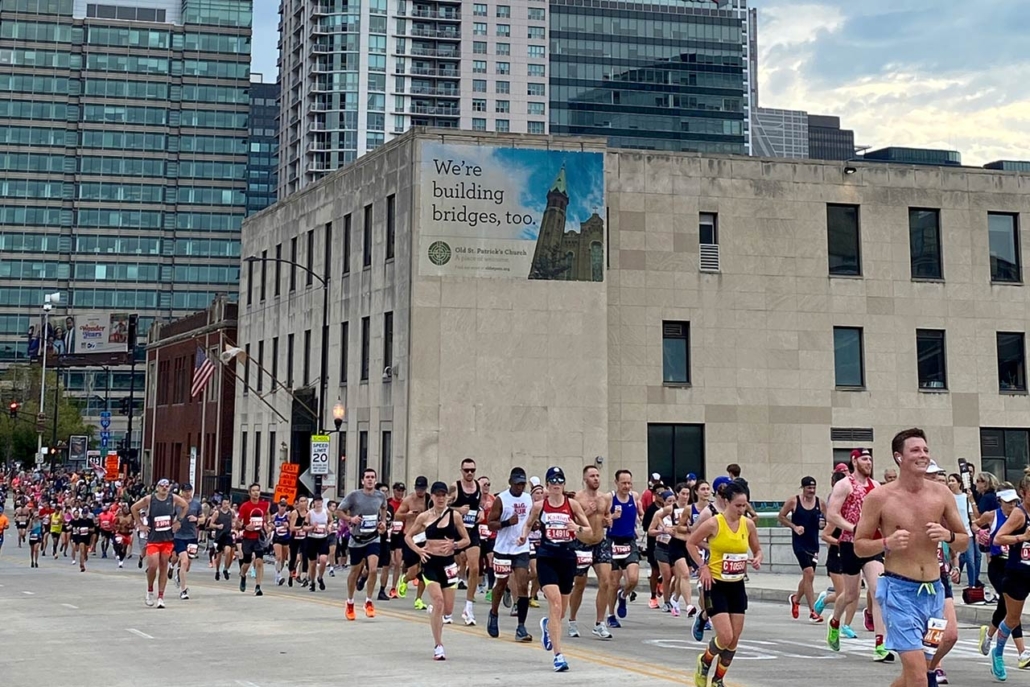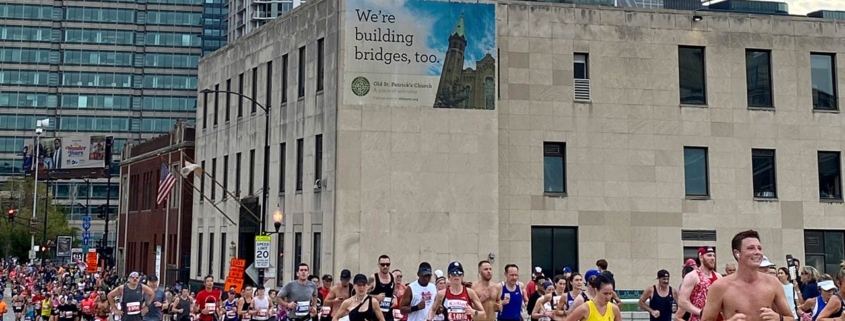Neighborhood News… Chicago Marathon: 26.2 Miles and 118 Years to A World-Class Event

Along with the Berlin, Boston, London, New York City, and Tokyo marathons, the Chicago Marathon is one of the world’s six major marathons, their website proudly proclaims. And it’s taking place in Grant Park this weekend, Sunday, October 8, where an estimated 1.7 million spectators will cheer on 45,000 runners.
In the Beginning…
The very first Chicago Marathon was run on Saturday, September 23, 1905, according to Enduropacks.com. Sponsored by the newly-formed Illinois Athletic Club, the race was 25 miles long, In 1905, 20 runners registered for the first Chicago Marathon, 15 actually started the race, and 7 finished. The race began in Evanston and finished in front of a standing-room-only, paying crowd at Washington Park race track, according to the Chicago Tribune. In a stunning upset, according to the blog, a reported 100,000 or more spectators watched Rhud Metzner come from behind to steal a late-race victory from the favored Louis Marks.According to the book Chicago Marathon, Marks collapsed, but got up and finished the race.
The Chicago Tribune also pointed out that the Marathon wouldn’t grow to 26.2 miles until after the 1908 London Olympics.
And, according to Wikipedia sources, the Chicago Marathon has never excluded women, unlike other cities. Historically, however, Wikipedia notes, the women’s field has been smaller than the men’s. This seems to be the result of older age categories having large multiples of men to women, but the women are beginning to outnumber the men in the 20s age group of the field.
The Modern Era- 1977 to Present
Annual Chicago marathons were held from 1905 to the 1920s, the later runs sponsored by the Chicago Daily News, but spent the next several decades in limbo.
It was not until the health consciousness of the 1960s, according to Wikipedia sources, that marathon growth gained traction. Frank Shorter’s 1972 Olympic marathon victory represented the convergence of many middle-class American ideals. Then the 1976 New York City Marathon, which was the first New York City Marathon to embrace the five borough course, popularized the big city marathon.
As the ‘Second City,’ Chicago wasn’t far behind New York. The modern era Chicago Marathon, according to Wikipedia sources, was founded over the objection of Ed Kelly, Chicago Park District Superintendent who refused permission to run in the parks or along the Lake Michigan lakefront. With the help of Lee Flaherty, the event’s founder, Mayor Richard J. Daley’s support for the marathon was enlisted. Although Mayor Daley died, his successor Michael Bilandic, a runner himself, approved the race and got Kelly on board. the first marathon on September 25, 1977 and called the Mayor Daley Marathon, with 4,200 participants. Britain’s Steve Jones recorded Chicago’s first-ever world record in 1984.
Carey Pinkowski took over as Chicago Marathon director in the 1990’s, when only a few thousand runners participated, according to a Chicago Tribune profile. At that time, he recalled, he would sweep the course himself the morning of the race — and even hand out race bibs to last-minute runners.
“Very early on, I saw the Boston Marathon and the tradition and New York with its urban experience,” he told the Chicago Tribune. “(Fred Lebow, co-founder of the New York City Marathon) was saying, ‘You’re going to see events with 30,000-50,000 people. People are going to discover this activity.”
In 1990, the Chicago Tribune noted in Pinkowksi’s first year at the helm, 6,168 runners finished. As his biography notes, over 30-plus years, the Marathon grew to a record 45,932 finishers in 2019, including runners from all 50 states and more than 130 countries. He and his team did this by building the marathon’s relationships with the city, the corporate community and the local neighborhoods along the course. They also introduced charity runs and Paralympic marathons.
The event began attracting elite runners in the mid-80’s, as prize money and prestige grew. Four of the Chicago Marathon’s five world records have been set during Pinkowski’s time: Morocco’s Khalid Khannouchi (1999), Kenya’s Catherine Ndereba (2001), Great Britain’s Paula Radcliffe (2002) and Kenya’s Brigid Kosgei (2019).
Present Day: Parallels to the past
This Sunday, runners will wake up, stretch, and have the same dream that runners did in 1905: to reach the finish line, no matter what it takes.
According to Runtri.com, like the 1905 inaugural race, today’s Chicago Marathon route is an unparalleled city showcase, passing Millennium Park, the Loop, Lincoln Park Zoo, Lake Shore Drive, the Lyric Opera House, The Mercantile Exchange, Greek Town, Chinatown and finally, the Grant Park finish area.
Along the way, three of the city’s main stadiums are near the course’s turning points: Wrigley Field to the north; the United Center to the west; and Guaranteed Rate Field to the south. The city’s fourth professional stadium, Soldier Field, is located near the start/finish area.
The loop course starts and ends at Grant Park. For more about Sunday’s Chicago Marathon, click here.
Alison Moran-Powers and Dean’s Team Chicago



